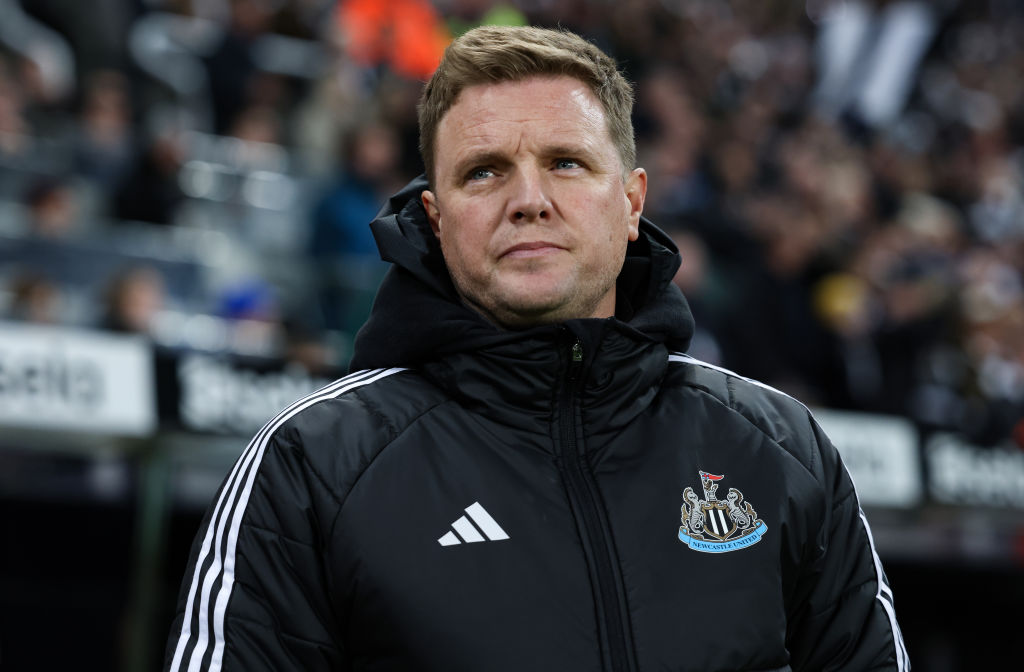Gianfranco Zola: How the Chelsea legend weaved his magic as English football watched in awe
Long before Roman Abramovich’s billions and Jose Mourinho’s opinions, there was a tiny Sardinian who transformed the face of Chelsea forever...
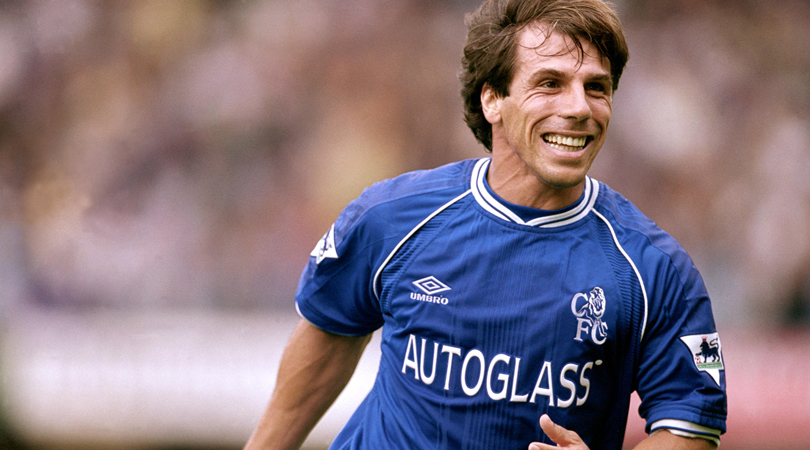
It was almost 11pm in Cheshire when the helicopter fell from the sky. Matthew Harding was making his way back to London, having watched his beloved Chelsea slip to defeat at second-tier Bolton in the League Cup. He never made it home. Along with four others, the Blues’ vice-chairman died on that fateful October night in 1996.
Harding was a figure of hope, following an awful quarter-century for Chelsea. Between 1971 and 1996, the club won no major titles and finished outside English football’s top 10 on 21 occasions. Without their investor, their prospects seemed uncertain once more.
A fortnight after Harding’s death, a new figure of hope arrived at the crucial moment. Gianfranco Zola was just 5ft 6in tall, but he changed everything. In the 25 years since the Italian’s arrival, Chelsea have never finished outside the top 10 and celebrated 20 major trophies. Few players have altered the course of history in such pivotal fashion.
If Zola was special, it was because he learned from the grand master. He was an unpolished diamond, still competing in Italy’s third tier in his native Sardinia when spotted by Napoli in 1989, aged 23. He was welcomed to Stadio San Paolo by one Diego Maradona. “Finally,” the Argentine told him, “they’ve bought a guy even shorter than me!”
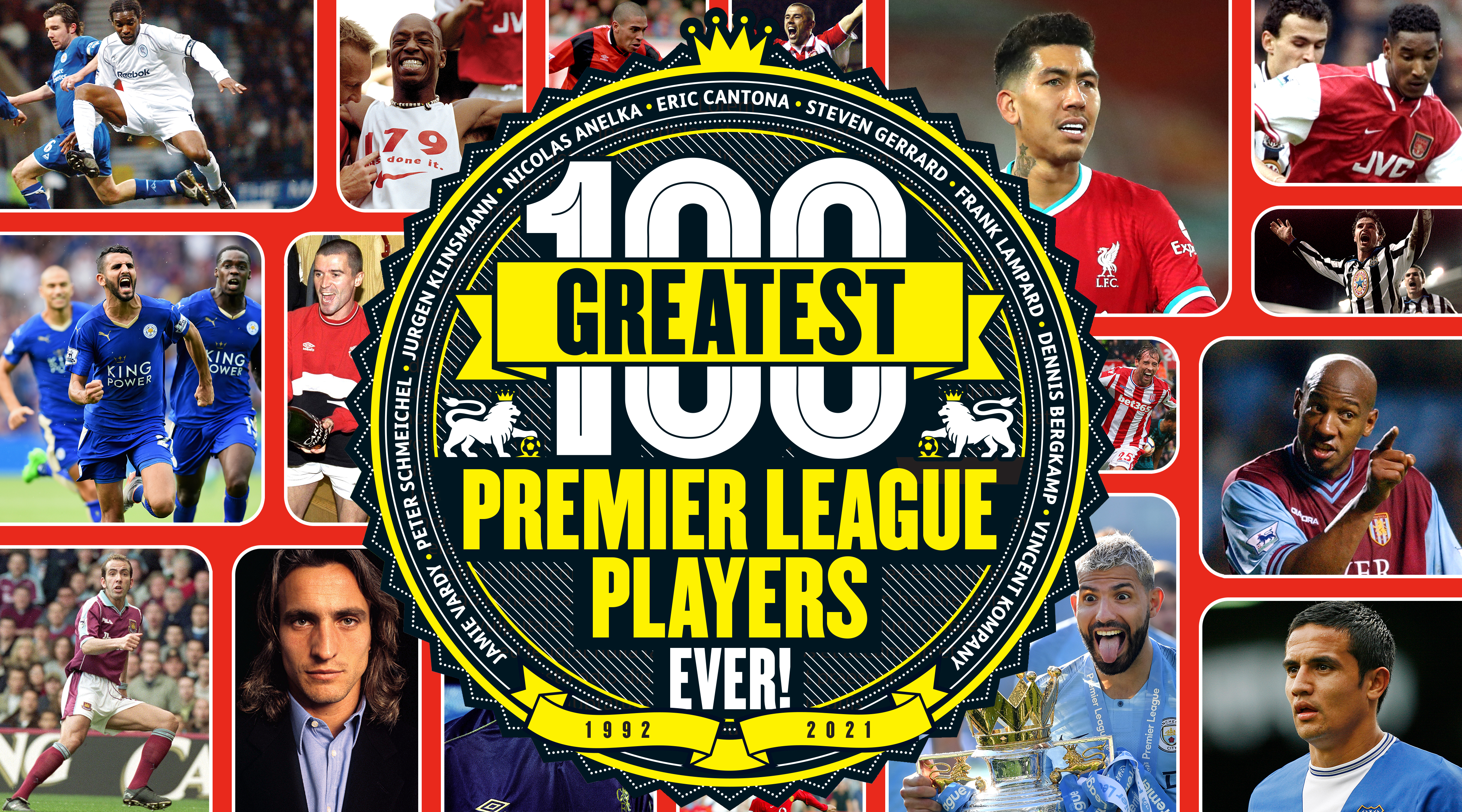
THE FULL LIST 100 greatest footballers in England's top flight since 1992
Zola played only a fringe role as the ‘Little Donkeys’ secured the 1989/90 Scudetto, but spent as much time with Diego as possible.
“‘El Pibe’ was so important for Gianfranco,” says Massimo Crippa, who played alongside the Italian for Napoli, Parma and the national team. “They had similar characteristics, and Zola gained so many outstanding skills from Diego’s technical knowledge.
“They’d spend a very long time together on the training field, trying different free-kicks. Gianfranco was a bit shy at the start but he had great qualities. Even though he wasn’t very tall, he was hard to mark and so strong. When Maradona left the club in 1992, Zola was given the No.10 jersey and then played extraordinarily well.”
Get FourFourTwo Newsletter
The best features, fun and footballing quizzes, straight to your inbox every week.
In 1992/93, Zola scored 12 Serie A goals and provided 12 assists, the joint-highest tally in the league. As Napoli began to struggle financially, Parma swooped with a £6m bid. He netted 18 times in his first campaign at the Stadio Ennio Tardini, but disappointment was to follow at USA 94.
On July 5, Italy trailed 1-0 to Nigeria in the last 16 when Zola was introduced from the bench for his first tournament appearance. Eager to make an impact, and believing he had been denied a penalty after falling inside the area, he had an uncharacteristic rush of blood – charging after Augustine Eguavoen and chopping a boot across the defender to win possession back. Eguavoen went down and Zola was shown a red card, responding by kneeling on the pitch, arms folded like a crestfallen child.
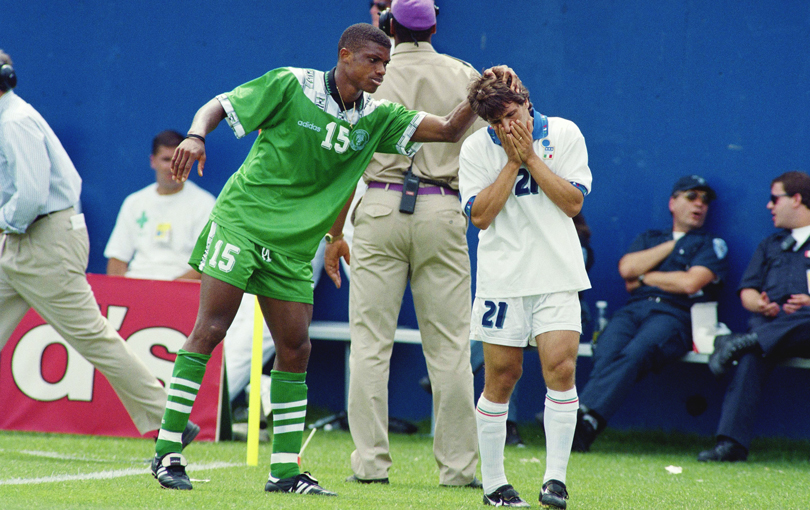
He’s the only player to be sent off on his birthday in World Cup history. It could have cost Italy, had Roberto Baggio not bagged a brace to rescue the 10-men Azzurri. Zola was available from suspension by the time they reached the Rose Bowl final, but he wasn’t called upon.
The following season, he hit back with his highest ever goal tally, scoring 28 times as Parma challenged for a first league title and won the UEFA Cup. Hristo Stoichkov’s arrival soon altered Zola’s role, however, before he suffered more tournament misery – missing a decisive penalty against Germany as Italy exited Euro 96 at the group stage.
Months later, Zola decided to leave Serie A, after new Parma boss Carlo Ancelotti began to play him on the left of a rigid 4-4-2 system. “Ancelotti had other intentions for him – he preferred to use that kind of player as a wide midfielder, but it wasn’t Gianfranco’s role so he decided to consider proposals from other clubs,” Crippa tells FourFourTwo.
CHELSEA TRANSFER NEWS Blues to consider selling one of Christian Pulisic or Hakim Ziyech
“I was really surprised when he moved to England, but Chelsea were quite an Italian team at that time, with Gianluca Vialli, Ruud Gullit who’d played in Serie A, and Roberto Di Matteo. Seeing what he did at Chelsea, it was the perfect choice.”
It seems implausible in 2021, but there was scepticism in the Chelsea squad when Zola joined for £4.5m in November 1996.
“When he first arrived, John Spencer was in the team and playing very well,” ex-Blues defender Michael Duberry tells FFT. “Everyone loved Spenny, so Gianfranco came in and we all wondered, ‘Why do we need this guy?’ He wasn’t one of the biggest names coming out of Serie A. When he started training though, I thought, ‘Wow, all is forgiven, he can play... I love Spenny, but this guy is unbelievable’.”
"An extraordinary individual effort!"#GoalOfTheDay is courtesy of Gianfranco Zola 🔵 pic.twitter.com/6Z7anKuSVdJuly 12, 2017
Already 30, Zola was desperate to make an impact. He was handed a debut at Blackburn in November and was Premier League Player of the Month by the end of December, after netting five goals in six games. By February, he had scooped BBC Goal of the Month after collecting the ball near the byline at home to Manchester United, then bamboozling Denis Irwin and Gary Pallister to somehow work his way into a position to fire home.
Zola’s long-range stunner helped Chelsea come from 2-0 down to beat Liverpool in the FA Cup fourth round, then a brilliant piece of skill outfoxed the Wimbledon backline as he scored in the semi-finals at Highbury. By the end of the campaign, Chelsea had secured sixth place in the Premier League – their first top 10 finish since 1990 – and another clever Zola flick laid on an assist for Eddie Newton as the Blues beat Middlesbrough 2-0 in the FA Cup final. Finally, the 26-year major trophy drought was over.
Before that, Zola had been named Football Writers’ Association Player of the Year – he’s still the only man to win the award despite arriving in England partway through a season.
Hard work complemented his talent. “Gianfranco would be one of the first on the training field and one of the last off,” recalls Duberry. “There was one time when the boss, Ruud Gullit, said to the young English players, ‘You lot aren’t technical enough, so you’re going out half an hour early to do some skill exercises’. There was Jody Morris, Andy Myers and myself, and we saw it as a punishment. Why were we having to do that when Frank Leboeuf and Roberto Di Matteo were in the changing room sipping espressos, watching us from the window and laughing?
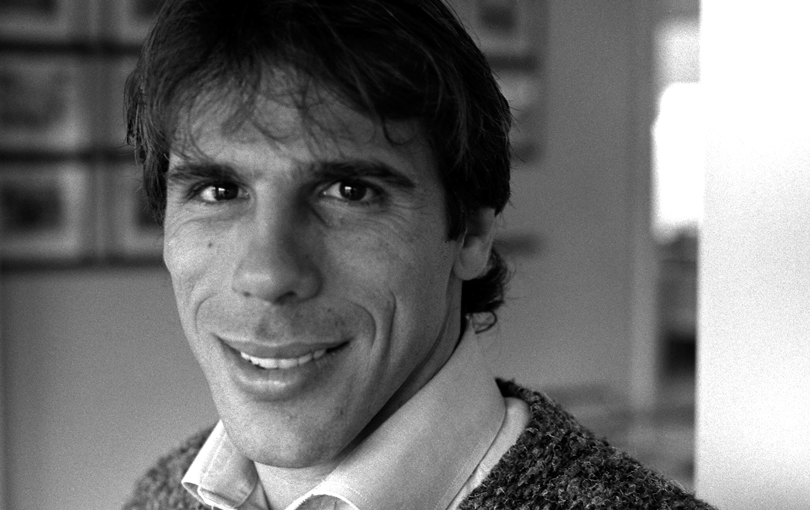
“Zola sensed that. He’d say, ‘Dubes, come on, I’ll come and do them with you – it’s not punishment. See it the other way, as a way to better yourself’. He and Vialli both came out. When you could see Gianfranco getting something out of it, everyone else changed their approach. He was only around 4ft 2in, but was a mammoth of a man – his gravitas, his warmth. When people ask me to name the best I ever played with, I don’t hesitate – it was Zola.”
During his debut Premier League season, the forward struck a winner for Italy against England at Wembley, in qualifying for the 1998 World Cup. He began to assist Chelsea in Europe, too. Already League Cup winners in 1997/98, the Blues reached the European Cup Winners’ Cup final thanks to three Zola goals en route. Struggling with injury before the showpiece against Stuttgart, the Italian was named on the bench – then hammered home the only goal of the game within 30 seconds of his introduction.
Season after season, the magic continued. In 1998/99, Zola helped Chelsea come third and seal Champions League qualification for the first time. He was still at his dazzling best as the west Londoners reached the last eight, thumping Galatasaray 5-0 at the infamously intimidating Ali Sami Yen in the group stage courtesy of a Gianfranco masterclass.
CHRIS FLANAGAN What happened to England's "Golden Generation"? How the country's most talented squad never came good
“Before the game, Galatasaray supporters smashed the windows on our bus,” Gus Poyet told FFT. “But we had Zola. When he came off after 80 minutes, those same fans stood up and applauded him.”
At the start of that 1999/2000 campaign, Zola had pondered calling time on his career come the season’s end, but thankfully didn’t. He bookended it with an audacious scooped assist for Poyet to score a flying scissor-volley against Sunderland on the opening day, and a teasing set-piece which produced a David James error in the last FA Cup final at the old Wembley against Aston Villa.
The Italian wasn’t exempt from dressing room banter, though – unsurprisingly, Dennis Wise was at the heart of it. “Gianfranco was reading a John Grisham book, a cliffhanger where it all came together in the very last chapter,” remembered Graeme Le Saux. “Our captain decided it would be funny to tear out the last chapter and Gianfranco didn’t realise, so we watched him getting closer to what he thought was the end of the book, until one day in the dressing room, he got there. That was the first time I saw him lose the plot – he was going around accusing everyone of stealing the pages, demanding them back!”
Zola signed off in style as Chelsea beat Liverpool to top four spot#OnThisDay 17 years ago... pic.twitter.com/P1aRTTHVRgMay 11, 2020
Zola turned 34 in the summer of 2000, but still he kept producing. His football brain, his biggest asset, was as sharp as ever.
“He was a footballer who wasn’t dominant physically, but gained his advantage through intelligence and innovation out on the pitch,” says Mario Stanic, who played alongside Zola during the Italian’s final years at Stamford Bridge. “He saw things before anybody else. He showed that with a professional attitude and the correct mentality, you can continue to play dominantly in your 30s. We shared a dressing room for three wonderful years – he embraced new players and made us feel part of the team.
“I’m still in touch with him today. The two of us would play football-tennis all the time at training – he used to arrive an hour and a half early so we could play. It was always full of laughs and crazy tricks.”
Breathtaking skills were never far away when Zola was around, his most notable coming in Chelsea’s 2001-02 FA Cup run. That season, the veteran was beginning to face a battle for his starting place, as Claudio Ranieri tried to lower the team’s average age by pairing Eidur Gudjohnsen with Jimmy Floyd Hasselbaink upfront.

He hit back by reasserting his class at home to Norwich, meeting a low corner at the near post and flicking a backheel volley into the net. Only an artist like Zola could have scored a goal like that.
“It was a wonderful goal, although it wasn’t surprising for us as team-mates,” Stanic tells FFT. “It’s understandable that it looked great to everybody else, but when you saw what he did every day at training, that was just an ordinary day for him. What made Gianfranco so fantastic was the ease with which he did flicks and tricks like that. He was an individual who always put the team first, a quality that is extremely rare for players as good as him. But he never doubted his own ability.”
Remarkably, that continued belief allowed Zola to regain his spot in 2002/03 and notch 16 goals – the best haul of his Chelsea career, earning him their Player of the Year award. In the closing stages of the final game of the season, the 36-year-old schemer tormented a defender some 11 years his junior, turning Jamie Carragher inside out and sending the Liverpool stopper tumbling, before darting past two more bamboozled Reds in a sumptuous piece of skill.
It would prove to be Zola’s final act in blue. His displays at Stamford Bridge had played a significant role in tempting Roman Abramovich to purchase the club, but days before the Russian billionaire’s takeover was completed, Zola decided to return home and play the remainder of his career in Sardinia.
Desperate to keep the out-of-contract Italian in England, the incoming owner upped the terms of the new deal on offer at Chelsea, but Zola had already agreed to join Cagliari. Abramovich was said to be so disappointed, according to unconfirmed reports, that he swiftly made an offer to buy the Serie B side.
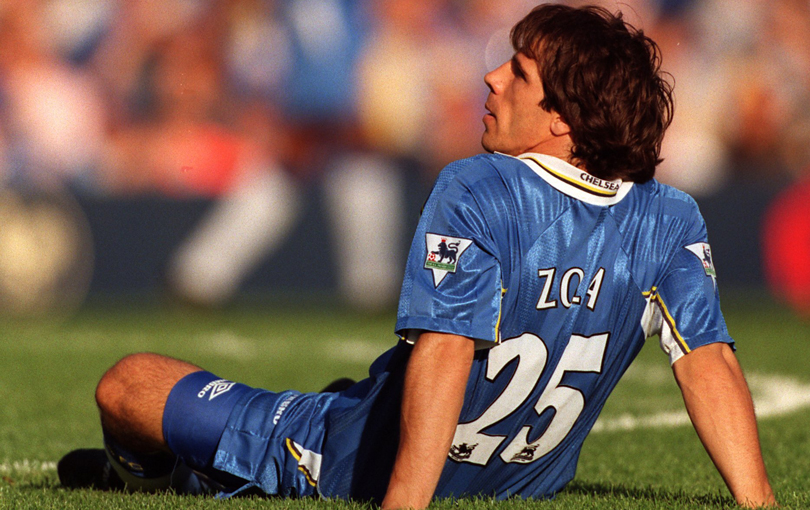
“Gianfranco was iconic at Chelsea – he was part of the attraction,” says Duberry. “It’s like if you’re buying a new house – you think, ‘Oh, I thought I was getting that nice lampshade. They took that as well? Why didn’t they leave that in there?’ The timing of him going was a shame, because maybe Abramovich would have invested in Gianfranco for a little longer, and we could have seen him lift the Premier League trophy even if he played a supporting role. Ian Wright got to lift the trophy towards the back end of his Arsenal career – it would have been lovely for Gianfranco to have that iconic moment, too.
“But what he did at Chelsea was great as it was, and the club did win things during that period. It was the influence he had on other Chelsea players like Frank Lampard, too. The attention to detail, to practise and work hard – it rubbed off on anyone who joined the club. People talk about Jose Mourinho putting that mindset into Chelsea, but Zola had already been doing it. He had such an impact there. He transformed the club.”
Legacies don’t come much better than that. Chelsea’s successful era began back on that autumn day in 1996, when Gianfranco Zola walked through the door at Stamford Bridge.
While you're here, subscribe to FourFourTwo today and save 37%. All the exclusive interviews, long reads, quizzes and more but with more than a third-off normal price.
NOW READ
TOM HANCOCK Should FA Cup replays be scrapped for good?
PSG When Neymar is out in late February: 7 times he's curiously missed matches
JONATHAN WOODGATE EXCLUSIVE “My period at Leeds was special – but I feel unfulfilled”

Chris joined FourFourTwo in 2015 and has reported from 20 countries, in places as varied as Jerusalem and the Arctic Circle. He's interviewed Pele, Zlatan and Santa Claus (it's a long story), as well as covering the World Cup, Euro 2020 and the Clasico. He previously spent 10 years as a newspaper journalist, and completed the 92 in 2017.
